A host of long-awaited updates to Portland’s bicycle parking code were in front of City Council this week. After four years of work to update them, we’re just weeks away from council adoption.
Our current code was adopted in 1996 and has not kept up with demands. The new code aims to set Portland on a path to nearly quadruple the rate of bicycling in 10 years. Its basic premise is that in order to convince 25% of Portlanders to consider riding on a daily basis we must provide accessible and secure places to store their bikes.
During testimony Wednesday, PBOT Active Transportation and Safety Division Manager Catherine Ciarlo broke it down in simple terms for Mayor Ted Wheeler, PBOT Commissioner Chloe Eudaly, and other councilors in attendance. “If there’s cheap, convenient [car] parking available, we’re more likely to drive where we’re going. If there isn’t, we’re less likely. The same principle applies for bikes. If there’s not convenient, secure parking we’re less likely to use a bicycle to get somewhere.”
But no major change in city code is that simple.
When passed (likely early next month), the code would create new requirements for building developers. It would mandate the amount, design, and location of both long-term (for employees and residents) and short-term (for business customers and visitors) bike parking spaces in new buildings.
Advertisement
Most of the code update has been non-controversial as there’s widespread understanding that we need to improve the amount and quality of bicycle parking citywide – especially in places like east Portland where Ciarlo said demand will skyrocket after PBOT builds 75 miles of bikeways there over the next five years. The issue that has caused the most heartburn is about how to deal with bike parking in new residential developments.
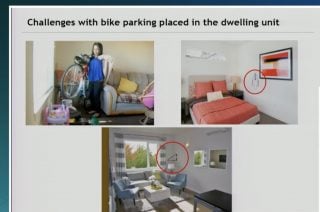
(Via PBOT slide)
The debate pitted two of Portland’s most cherished goals — more bicycling and more affordable housing — against each other.
Current code allows developers to put 100% of required bike parking inside dwelling units. That’s problematic on several fronts. PBOT found that only 20% of people surveyed preferred in-unit bike parking. They also heard many complaints that in-unit racks are often hard to use or non-existent and that building owners would keep security deposits after wet or muddy bikes caused damage. This tilted the policy preference toward bike rooms.
PBOT’s initial proposal would have allowed 0% of required long-term bike parking to be placed in-unit. That was raised to 20% after developers said bike room size requirements would have too much impact on building design. Then affordable housing advocates weighed in and expressed concerns that too much emphasis on bike rooms and bike storage in general would increase project costs. The Portland Housing Bureau wanted exemptions to the in-unit requirements.
But why should people who don’t have as much money have poorer bike parking options? If anything, they need the best bike parking possible. “Good bike parking is an affordability measure,” said Portland Planning & Sustainability (PSC) commissioner Chris Smith during testimony Wednesday. “Households that can make bicycles part of their daily routine save on transportation costs.”
With help from Smith and the PSC, the sides hammered out a compromise.

Advertisement
“A dedicated closet or alcove will add cost to housing by decreasing efficiency and quantity of homes produced… further complicating housing production.”
— Kevin Clark, Oregon Smart Growth
On any residential project with more than 5 units, 50% of long-term bike parking can be in-unit. At buildings with 12 units or less, 100% can be located in-unit. To address concerns about the quality of in-unit parking, the proposal would require all in-unit spaces to be located within 15 feet of the front door and they must be in a “closet or alcove” with ample room (based on standard bicycle footprint of 2 x 6 feet).
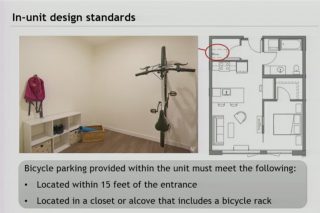
That last requirement doesn’t sit well with Oregon Smart Growth, a group that advocates for “sustainable development”. Kevin Clark, who sits on their board of directors, said during testimony they want the “closet or alcove” language removed from the proposal because it is “overly prescriptive,” “goes too far” and means that in-unit parking “won’t be feasible.” “A dedicated closet or alcove will add cost to housing by decreasing efficiency and quantity of homes produced… The Bureau of Development Services is already concerned that these design standards could add time and complexity to the permitting process, further complicating housing production.”
Later in the meeting, The Street Trust Executive Director Jillian Detweiler testified that she doesn’t support Clark’s position.
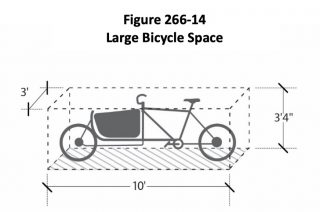
To further placate affordable housing developer concerns, PBOT Commissioner Eudaly introduced an amendment that would exempt 18 affordable housing projects currently in the pipeline. “This is a narrow exemption,” she explained Wednesday, “for 18 projects that have already been funded and fully scoped and having to go back and revise their plans could be incredibly costly and undermine the whole project.”
The new code also aims to make bike parking work for more people. PBOT staffer Liz Hormann said, “The current code is great for able-bodied Portlanders who ride a lightweight, two-wheeled bicycle.” For everyone else, there are new requirements for double-decker racks to have a lift-assist mechanism and a minimum of 30% of spaces must be horizontal (not hooks on a wall which require lifting). If you ride a cargo bike or other oversized bike with a trailer, PBOT is proposing that 5% of required parking spaces have a larger footprint of 3 feet by 10 feet.
Advertisement
“Not having access to dignified, secure bike storage close to home and work creates barriers that affect the most vulnerable people in our community.”
— Miché Lozano, Andando en Bicicletas y Caminando
During public testimony, City Council members heard about the lived experiences of Cully neighborhood residents. Members of Andando en Bicicletas y Caminando, a nonprofit that works to make cycling more fun and accessible for Cully’s many lower-income, spanish-speaking families. The group’s Program Director Miché Lozano brought several ABC members to testify.
Lozano shared how it took years of advocacy for Cully families to get 10 new bike racks. “And it’s still not enough,” they testified. “Many members of our community are denied long-term bike parking solutions and have endured unnecessary suffering at hands of landlords who target them for leaving their bikes on balconies or inside their homes – which are only places they have to safely store them.” Lozano also shared that bike theft is rampant in Cully and they implored councilors to help them. “Not having access to dignified, secure bike storage close to home and work creates barriers that affect the most vulnerable people in our community.”
Several ABC members, speaking through an interpreter, asked council for a bicycle garage so they could get their bikes out of their small apartments and out of the hands of thieves. One woman said she stores three bicycles in her house and fears “constant” searches by her landlord who doesn’t allow them inside the unit. “I don’t know what to do, they stole bikes just this month. I’m worried because my kids use them every day. Please come up with a solution.”
Diane Linn, executive director for affordable housing developer Proud Ground, testified that she understands the, “Critical importance for people of color needing this bike space, but at the same time,” she continued. “We have to be smart about how it would impact other elements,” of housing projects. “We just want to put it out there that we’re concerned how we pay for and support achieving what this bike parking code change represents and also recognize the implications of additional requirements in buildings that already have layers and layers of requirements for all the values the city holds dear.” Referring to bike parking as an “amenity,” Linn told council members the new code could result in less housing and/or smaller units being built and that the code would add to an “overload” of building permit requirements.
“It’s really disappointing to realize there’s been a demand for bike parking in low-income developments for a long time and developers aren’t seeming to be very responsive to that.”
— Chloe Eudaly, City Commissioner
“I appreciate your testimony,” Commissioner Eudaly said in response to Linn. “However after listening to the community members from ABC [Andando en Bicicletas y Caminando] it’s really disappointing to realize there’s been a demand for bike parking in low-income developments for a long time and developers aren’t seeming to be very responsive to that.” “And contrary to the myth out there that cyclists are affluent white people,” Eudaly continued, “the fact is that people who live on low incomes are more likely to bike and walk and depend on bikes than their more affluent neighbors who have cars… Kids need bikes. Of course I don’t want to see units eliminated, but we can’t just disregard this need.”
Two major needs that came up repeatedly at council Wednesday but are not included in this code update are some type of neighborhood bike parking solution, and the need to retrofit existing buildings. Chris Smith addressed these issues in his testimony: “We have lots of old buildings that have not enough or no parking at all. We also need a district parking solution where you could have a bicycle garage to cover the need generated by other properties that were built without bike parking that are difficult to retrofit.” “This is not the end,” of bike parking reform Smith said.
Mayor Wheeler too said this code update is just one piece of the puzzle. In his closing remarks he said, “It is not only my hope but my firm expectation that mode share will change precipitously in the next decade or so. It’s important we start somewhere… This is just one piece of the puzzle and I think it’s very important we push forward on this. If we’re serious about our climate action goals rather than just talking about them, this is the type of policy we need to lead on. And we will.”
Council will vote on amendments next Wednesday November 20th and a second reading of the ordinances is set for November 27th. You can still weigh in by leaving your feedback on the Map App. You can also learn more on the project website or view the draft recommendations here (PDF).
— Jonathan Maus: (503) 706-8804, @jonathan_maus on Twitter and jonathan@bikeportland.org
— Get our headlines delivered to your inbox.
— Support this independent community media outlet with a one-time contribution or monthly subscription.

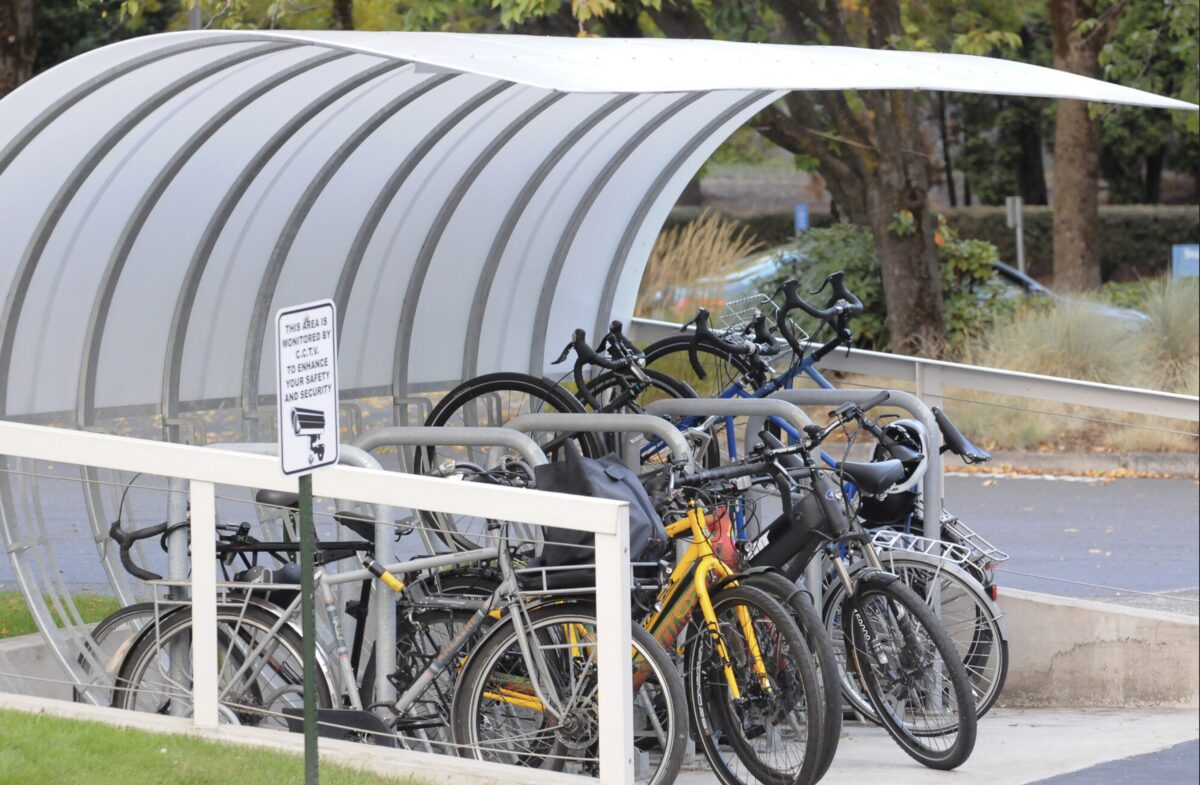

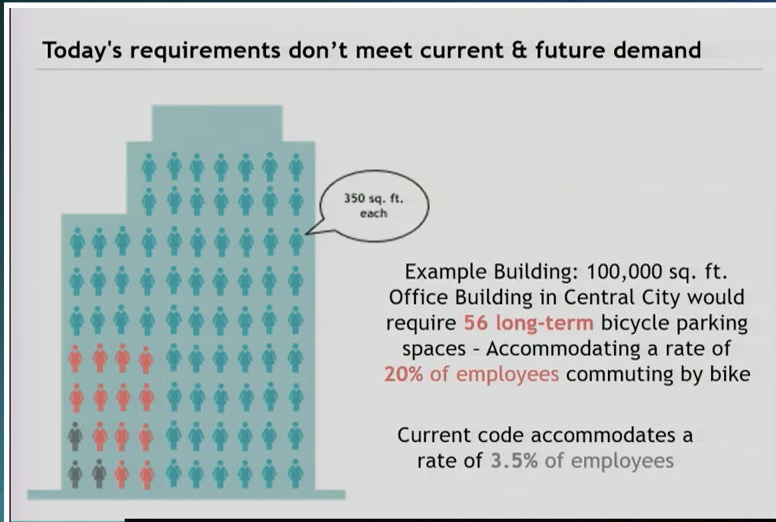


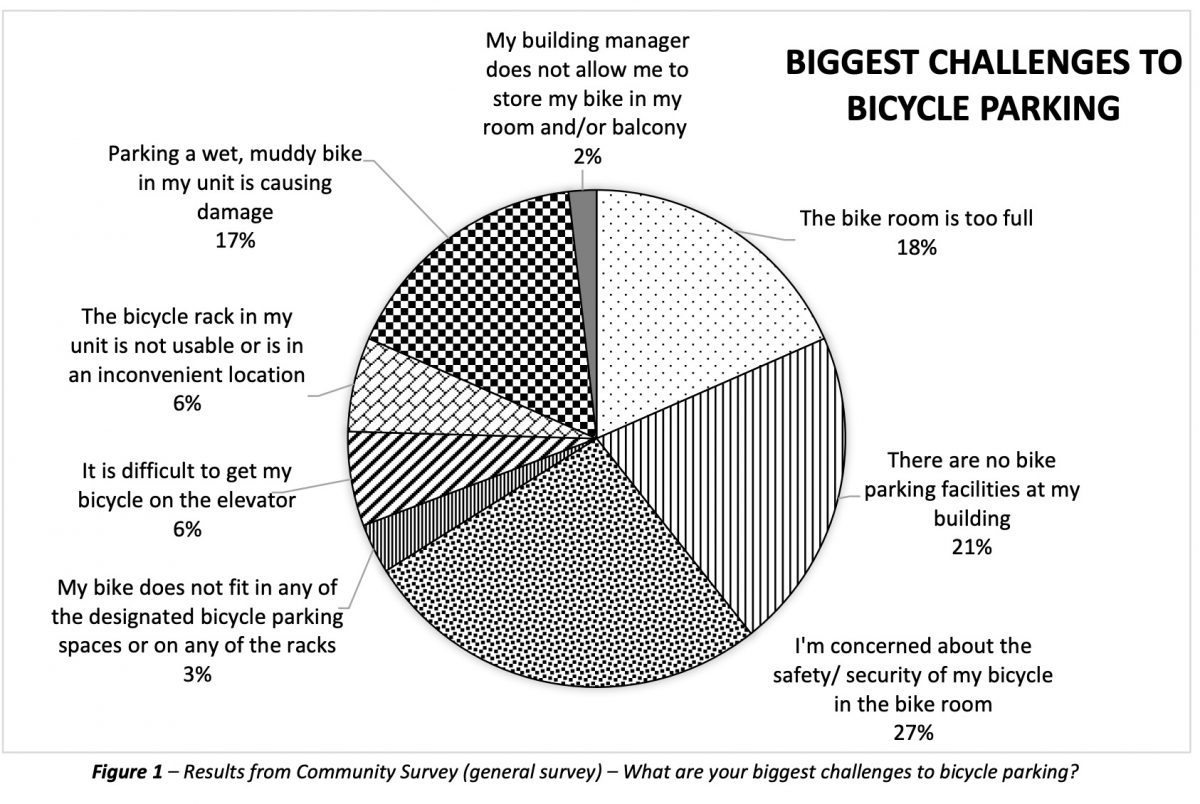

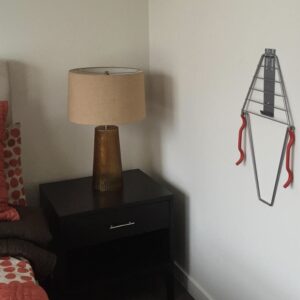

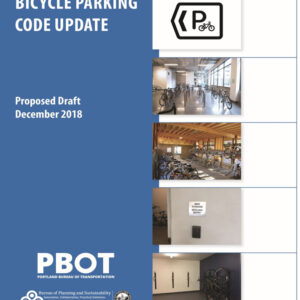

Thanks for reading.
BikePortland has served this community with independent community journalism since 2005. We rely on subscriptions from readers like you to survive. Your financial support is vital in keeping this valuable resource alive and well.
Please subscribe today to strengthen and expand our work.
I very much appreciate the supportive testimony in person and in writing from the community!
The top concern of tenants was security of bicycle parking facilities. In fact, a report commissioned by the Community Cycling Center found that tenants living in Hacienda CDC housing had 85 bicycles stolen from residents “which was nearly one bicycle per household”. Instead of addressing this concern in good faith, the committee listened to real estate firms concerned about their bottom lines. For example, tenants asked for enhanced security (e.g. something more than an easily circumvented conventional entry), video monitoring, and secure racks but got nothing more than ridiculous nonsense about cameras not being “permanent”:
https://www.portlandoregon.gov/transportation/article/743356
IMO, this anemic and toothless bicycle parking code update is yet another example of the decline of transportation alternatives in Portland.
Thanks for the good coverage, Jonathan, and for all your work on this issue, @chris Smith. The members of Andando en Bicicletas y Caminando (previously Andando en Bicicletas en Cully) really have been working (with the Cycling Center) for a DECADE to get safe and secure bike parking. We are thrilled to have this proposal moving forward, and we encourage everyone to jump onto the public comment page to register even more public support for it.
Thanks for the reminder, which prompted me to fill out the online form. Everyone who cares about cycling in Portland should fill out the online form – it’s so easy!
I think I filled that out.
I don’t have any answers here but I tend to walk my dog in, around, and amongst the new apartment complexes on N Williams. Most have plenty of bike parking, but of that vertical hang it by the front wheel type.
Nobody uses those things. You see whole stands of them empty, surrounded by bikes locked to handrails. Whatever the regulatory outcome, it seems to me that mandating a lot of a solution that nobody uses is worst than some of a solution that will get used.
Yes! Some bike rooms are even advertised with gigantic lettering on the door or the building!
My old apartment building has an interior, secured bicycle storage room and it’s OVERFLOWING. I would be way more hesitant about storing a bike somewhere visible from the street.
Whatever is drawn up today still leaves hundreds of thousands of multifamily units in Portland that will never meet this code.
For the eternity it will take to replace them all, why not start with a ban on bicycle prohibitions in multifamily housing? I feel like the city already did this for commercial buildings years ago, back when Sam Adams had an office in City Hall.
Meant “worse” not “worst”.
And frankly it’s not even clear that anybody lives in any of these places or if they’re just some scheme for REITs to scam Chinese investors.
Lots of homeless in the Cully area along with many piles of bike parts. It’s not hard to see where their bikes are going. But hey we gotta look the other way when it comes to our vulnerable citizens.
Toby,
I really don’t like this comment. I almost deleted it, but have decided to leave it up. I just think it’s really unnecessary to bring that up in this context. Even if the context was right, I’m not comfortable with making these type of allegations that tie bike theft to homeless people. It’s ugly and unfair and leads to more hate and I don’t want this site to do that. I hope you understand. Like I said, I have a very tolerant approach to comments, but I wish you’d think twice about making comments like this. Thanks.
Way back when, I think in the 1890s or 1900 or so, in Portland and many other US cities the first paved streets, cycle tracks really, were paid for by subscription by the users.
Given that bike theft is so rife in Portland and a very real concern for both rich and poor users alike, I wonder if bicycle users would be willing to pay for a subscription service to pay for increased policing of bike theft, more prosecutions, fencing stings, and either longer sentences for repeat offenders or more rehab for minor offenders, a bit like downtown businesses already do? If NYC can reduce the incidence of bike theft, and the Netherlands virtually eliminate it, why can’t innovative and progressive Portland do it? If you didn’t have significant issues with bike theft, you wouldn’t need these heavy-handed and expensive bike parking ordinances, would you?
It seems that innovative and progressive Portland can’t do a lot of things that less innovative and progressive cities do.
I think we’re keeping up with our innovative European counterparts on this measure.
“Unfortunately, bicycle theft is a common occurrence in Holland. Every year, hundreds of thousands of bicycles are stolen.”
https://www.holland-cycling.com/tips-and-info/safety/bicycle-theft
Do we want housing for people, or housing for bikes?
I actually want housing for developers who can make nesting work more reliably!
Do you have a better suggestion on how to reduce bike theft in Portland?
Everyone recognizes this problem and yet you want to be complicit in sweeping it under the rug. As I recall, you once found your own stolen bike in a tent camp under I-5; and we all know that the homeless population isn’t buying all their bikes and bike parts at local shops or acquiring them as donations from the CCC.
I disagree with you Buzz. I don’t want people throwing around harmful generalizations that IMO don’t actually help improve the situation. I don’t think stereotypes or lazy generalizations of any segment of our population are helpful and I think they are extremely hurtful. There are actually quite a few homeless people who rely on bicycles to live and whom do take part in programs that help them acquire bicycles and/or attain them in the same way you and I do. And it’s not up to us to judge how/where people get their bikes. Let’s focus on finding illegal activity and then dealing with it. Let’s make sure people are considered innocent until proven guilty.
And to say that I’m “complicit” in sweeping bike theft under the rug is an absolutely wrong and crazy to say. As I recall, it was BikePortland that helped establish the PPB’s Bike Theft Task Force, the group of specially trained officers who have recovered 100s of bikes from homeless camps since it was formed.
Let’s agree to disagree; because, while I empathize with the many people on the street down on their luck for no fault of their own and in need of basic transportation, there are even more that are so disenfranchised that they don’t think the rules apply to them any longer, and bikes and bike parts are only a form of currency to them. I don’t know the exact stats, but I would estimate that for every bicycle the PPB recovers, 20 to 50 disappear forever; they just don’t have the interest or the resources to invest in this problem.
BikePortland thanks for keeping us updated! (As one of the former committee members for this code update I have just assumed it had already sailed through…but I know better.)
I have to ‘sadly laugh’ at the developers’ statement “said bike room size requirements would have too much impact on building design” [even though I have worked with many developers on bike parking, its often more tough task since this is often the last “use” to be added to a design]…if “they” really want to complain just look at many of the development communities’ buildings that must have 3 to 5 levels of car parking as a building pediment above the ground level.
Let’s not gorget the need for secure, covered bike parking at the other end too – at work!
People csn have all the amazing bike parking in the world at home, but if it is too sketchy or exposed to the elements to leave your bike unattended for nine long hours at the other end of things, nobody is going to bike commute anywhere.
This code package increases parking ratios for office and commercial uses by several multiples!
It seems like one potential solution could be relaxing car parking requirements in exchange for better bike parking in new construction. For existing housing, converting car parking to bike parking seems like a possibility that could be explored. Car parking seems like a motherlode that could be mined in this situation but it wasn’t mentioned in the article.
We’ve been systematically reducing car parking requirements over the last few years. There’s not much left to give back.
My big issue is that bike parking efforts have focused so much on requiring buildings to provide it, without much attention being paid to providing public bike parking. Contrast that with how much effort and resources go into providing public parking for cars (on public streets and in public parking garages).
So this quote by Chris Smith was just perfect: “We also need a district parking solution where you could have a bicycle garage to cover the need generated by other properties that were built without bike parking that are difficult to retrofit.” (I’d also like to see smaller parking areas, with or without roofs, created in what are currently on-street vehicle parking spaces.)
Thank you Chris, and thank you Jonathan for making sure that got into the article.
The drawback to any public or common-area bike parking is theft. You really need an attendant, which makes things expensive, or lockers, which makes things expensive.
I’m talking about public in the sense that it’s publicly provided, versus provided by a building owner. Who owns the facility isn’t as relevant to theft as the type of facility. So, for instance, short-term parking in racks at the sidewalk that serves patrons of nearby businesses is probably just as secure if provided by the City than if provided by a building owner.
Privately provided long-term parking in a room that serves employees of one business could be more secure than the same type of space that’s publicly owned and open to anyone, but what makes it more secure is the fact it’s not open to anyone, not that it’s privately provided.
We saw a movie recently of a thieves stealing from what appeared to be a locked bike room. I used to think that was secure; I no longer do.
I remember seeing that and I agree. I wonder what the theft rate is at the attended parking at the base of the tram?
I forwarded that clip to the property manager working on increasing and upgrading bike parking at my building, in an attempt to get him to spring for 3/4″ mesh around the cage rather than 2″. He winced, but sorry, the project is already thousands over budget, and the garage is limited access. It’s really sad to not be able to get it right the first time.
I would like to see this, also. I have to go downtown later this week for an all-day event. I never bike downtown for anything but short trips with short parking needs. I have no idea what to expect in terms of bike parking, and I don’t really want to lock up my bike on the sidewalk downtown, all day. When I am downtown, I don’t typically notice that many bikes locked up on the street – at least bikes that look like they are long-range commuters. Where do most people who work downtown actually park all the bikes I see them riding to/from downtown during the day? Where is there secure public bike parking downtown for single day use?
I guess I just assumed most of the buildings had private bike parking.
Buildings (at least newer ones that were required to have parking) are required to have some long-term parking spaces, but they’re for occupants and visitors of the building. So if you’re wanting to park your bike there to work or go to an tenant in that building, you’re set. But if you want to go to an event in Waterfront Park or shop at several stores, or go to a restaurant in an old building, you’re out of luck, unlike if you have a car to park.
Seinfeld kept his Gary Fisher hung in his NYC apartment…
It was a Klein.
And Jerry drove SAAB.
I recommend any customer with an e or cargo bike (or fancy pants bike) and access to a garage or shed to consider installing these wall or floor anchors and using a maximum security chain for attachment:
https://www.abus.com/eng/Mobile-Security/Bike-Safety-and-Security/Locks/Wall-Floor-Anchors/GRANIT-WBA-100
Thank you for the link!
They are about $60 each plus shipping through the German website Bike24: https://www.bike24.com/1.php?content=8;product=5508;menu=1000,5,74;mid%5B72%5D=1;sort=price_desc
Kryptonite makes something similar, the Stronghold Anchor, $50-$100 depending on the source: https://www.kryptonitelock.com/content/kryt-us-2/en/products/product-information/current-key/330202.html?type=bicycle
I wish we could get a bike parking staple in the furnishing zone where needed upon request. The current system of getting sign-off from the property occupant and owner and Congress is prohibitive. If it turns out to be a problem for some unforeseen reason then remove it. That would be so much easier. It’s just a staple.
I am an architectural designer in Madison, WI. We are required by city ordinance to supply 1 secure bike space per bedroom ( and more for over 3 bedrooms) plus visitor bike parking , mostly inside the building, for all multifamily projects. This typically takes up 5 or 6 under ground parking spaces, which the developer would normally rent out for $100/month. People want to live in Madison. Developers want to build in Madison; and they just suck it up and supply the bike parking. Developers will ALWAYS whine about having to spend more money! They are still wealthy, aren’t they?